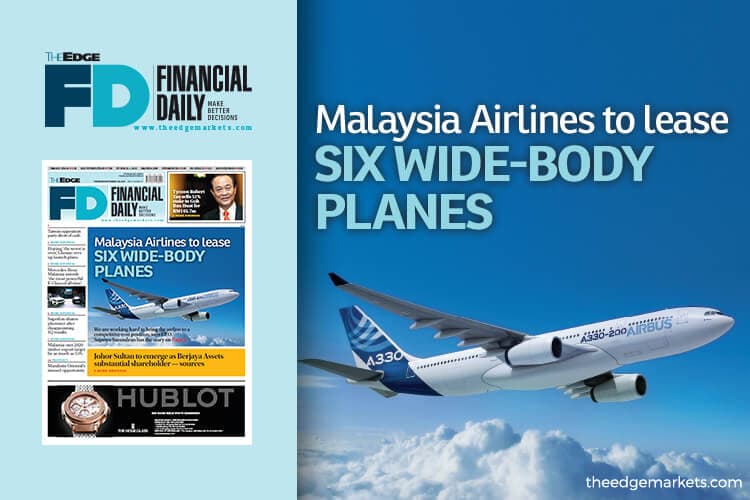
This article first appeared in The Edge Financial Daily on September 28, 2017
KUALA LUMPUR: Malaysia Airlines Bhd is leasing six second-hand Airbus A330-200s from AerCap Holdings NV, as it seeks to bring in wide-body planes to replace its ageing single-aisle jets.
“As laid out in the ongoing five-year MAS Recovery Plan, we are working hard to bring the airline to a competitive cost position. We also want to rebuild Malaysia Airlines so [that] we can reassume our previous premier position in the industry,” chief executive officer Peter Bellew told a news conference yesterday to update the national carrier’s turnaround plan that began in September 2014.
“As I have communicated, we have an immediate need for wide-body aircraft to offer more lie-flat beds in business class on our flights over three hours. Malaysia Airlines has done an opportunistic deal on super aircraft from a failed European carrier. I am grateful to AerCap for its speed in working with Malaysia Airlines to help rebuild our premium business,” he said.
The six planes were once part of the now-bankrupt Air Berlin fleet.
Yesterday, Malaysia Airlines inked a letter of intent with Dublin-based aircraft leasing firm AerCap for the lease of the six A330-200s, as replacement for six narrow-body Boeing 737s that are being returned to lessors.
The A330-200s, which are expected to begin arriving from February 2018, will be leased for six years from 2018 through 2023 and will mainly be used for destinations such as Mumbai, New Delhi, Shanghai, Hong Kong and Bali.
“These ex-Air Berlin aircraft ... they have recently had a massive refurbishment programme done on them. They have brand new interiors and galleys, and have had heavy maintenance conducted on them,” said Bellew.
He did not share as to how much the leasing costs were, except that the “current lease rates are incredibly competitive and we are being opportunistic by leasing them at this point”.
Malaysia Airlines currently operates six A380s, 15 A330-300s and 48 B737-800s, bringing its total fleet size to 69. It will also soon be taking delivery of the first of six new A350-XWBs — also on lease but from Air Lease Corp — which it will be using to operate the London route.
The airline has also ordered 25 of the new Boeing 737-Max 8 planes, with deliveries starting from the end of 2019, as well as 25 options.
Malaysia Airlines had also inked a preliminary deal with Boeing Co during a recent visit to the US with Prime Minister Datuk Seri Najib Razak, to potentially add eight wide-body 787-9 Dreamliners to its fleet from the third quarter of 2019. However, the announcement of the eight Dreamliners worth US$2.5 billion (RM10.55 billion) at list prices, drew flak from some quarters who questioned why the loss-making airline was buying the bigger and pricier aircraft if it is focusing on the intra-Asia routes, which can be served by narrow-body single-aisle planes.
“The 787-9 is just as economical going from here to Tokyo or to Beijing, than it is going from here to San Francisco. What the 787-9 does give is the flexibility and optionality — if we ever want to go back [to] those markets, we can,” said Bellew.
“I think personally there is going to be a shift in the aviation industry over the next three to four years [where] it will be less common to transit through the Gulf states [when travelling on long-haul destinations], as we are already seeing some contractions in the Gulf carriers.
“I think the price of oil will level off, and it will be much more affordable to do the longer-haul flying as well, and I think more people would want to go direct [to destinations in US and Europe],” he said.
Bellew said that over the next five years, the Malaysia Airlines fleet would see more changes in the type of aircraft rather than fleet size.
At present, the Malaysia Airlines fleet of 69 planes consists of 48 narrow-body planes and 27 wide-body aircraft, but this is expected to increase to 80 planes by 2022, consisting of 45 narrow-body planes and 35 wide-body planes.
“We have aircraft retiring that have come to the end of the lease, we are replacing those with new aircraft and as narrow-body aircraft get retired from the fleet, we will replace them with wide-body aircraft.
“So, the overall size of the airline over the course of the next five years will increase by somewhere between seven and 10 aircraft, which is a very moderate increase in an airline’s scope ... it’s more of a change of the type of aircraft we have,” he said.
On Malaysia Airlines’ new airline to operate its A380 fleet on religious pilgrimage charters, Bellew also said: “We have started the application for the licensing process with the Malaysian Aviation Commission and the Department of Civil Aviation Malaysia, and we are going through a feasibility study process with our shareholder Khazanah Nasional Bhd at the moment to make sure that there is financial feasibility in the project.”
“We have put the team together and they have come with a very detailed business plan, and its just good governance to do a feasibility study,” he added.